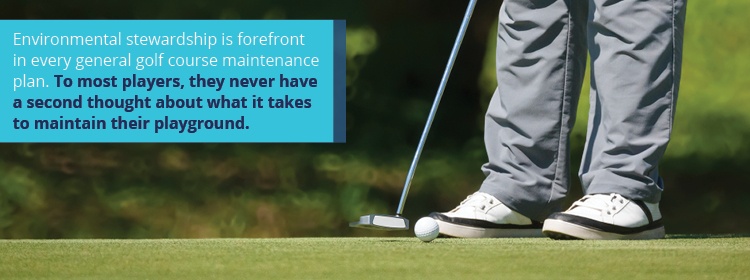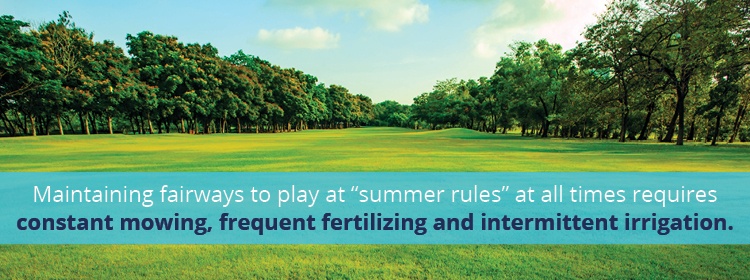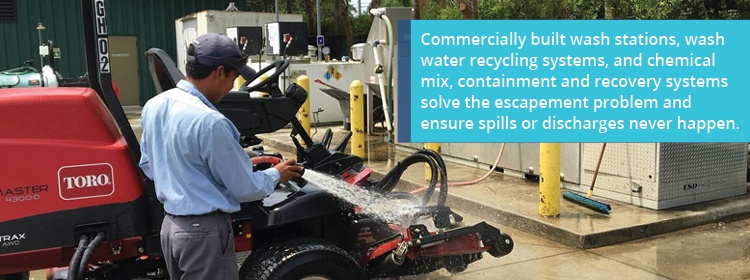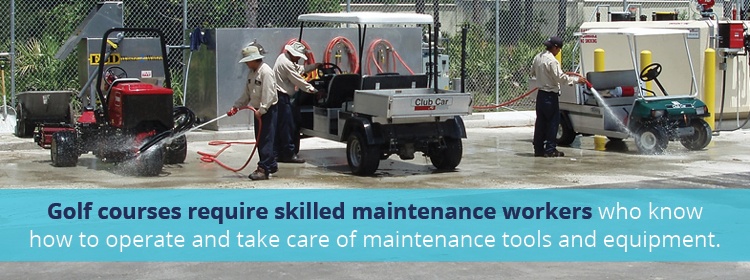Jump to:
Best Practices | Environmental Planning | Wildlife Management | Chemical Use Reduction | Water Conservation | Water Quality Management | General Maintenance | Maintaining the Green | Chemical Usage | Golf Course Pond Maintenance | Trees and Landscaping | Equipment Maintenance

Golf Course Management
Managing golf courses is a challenge for even the most experienced operators. Golf courses are a unique business where an artificial outdoor playing environment has to blend with nature and appear as natural as possible. Designing a course that makes golfers feel they’re part of the landscape while focusing on lowering their score is no easy feat. Neither is maintaining the course and equipment to keep it in peak condition.
Golf course managers and maintainers require a tremendous amount of knowledge. To “keep the green,” these experienced professionals must know everything from chemicals to cart repair. They also have to be knowledgeable in integrated pest management, irrigation techniques and equipment maintenance. That’s a diverse spectrum to handle, but golf course maintenance gets done daily at thousands of courses across America.
Golf courses are far too complicated for single individuals to maintain. Larger facilities, such as championship 18-hole golf courses, require a complete team to keep operations smooth and functional. Most players only see the front end of employees in the pro shop and catering to thirsty golfers waiting to tee on the next hole. They don’t see the support staff who start far before the first tee-off time and work hard to maintain the grounds, ponds, trees, and golf course equipment.
Golf Course Management Plan Best Practices
Golf course management is a fundamental aspect of the golf industry. While each course is unique, there is a set of general course management best practices. Some essential elements of golf operation and course management include:
Environmental Planning
Environmental planning helps course managers find the balance between creating an engaging course and respecting the environment. At first, course managers should create an initial environmental plan and site assessment.
Following these initial plans, course managers should assess these plans annually and make any necessary changes. Environmental planning allows course managers to help course superintendents and other employees care for the course, water, wildlife, land, and natural resources the course relies on.
One important aspect of environmental planning is training all employees on the importance of environmental performance and techniques that prioritize ecological quality. Course managers can document any environmental activities to aid with planning and tracking the progress of initiatives.
Wildlife and Habitat Management
Implementing environmental best practices can improve landscaping and natural habitats to promote biodiversity and wildlife conservation. It is important to take note of your course’s location, species and habitat considerations when creating and applying best practices.
Wildlife and habitat management help identify core habitats, including stream corridors, mature woodlands, and wetlands. Course managers should also identify any habitat concerns, including threatened or endangered species on or near the course.
It is important to educate and train staff to understand that course management practices can negatively or positively impact habitats and species located on the property. You can also maintain an ongoing log or inventory of dominant plants, mammals, birds, and other animals on the course.
Chemical Use Reduction and Safety
While chemicals are necessary for golf course management, it is still essential to employ chemical use best practices and implement pest management techniques to ensure safe application, handling, and storage. Chemical use reduction and safety can prevent potential contamination, which is often a concern with chemical applications.
Only trained, licensed applications should handle and apply pesticides in accordance with any law. Your team should also maintain a material safety data sheet (MSDS) for each chemical you have or use at the facility. Of course, closely reading and following all directions on a chemical product is important.
Although pesticides are essential, you should only apply these chemicals when pest threshold levels exceed the maximum value. It is important to address and treat problems at the correct time under ideal weather conditions to minimize harmful impacts and maximize their effectiveness.
Water Conservation
Another important area of concern is water use and conservation, especially regarding irrigation equipment to minimize water waste. Water irrigation and conservation practices ensure your course receives the water it needs while prioritizing efficiency and reducing waste.
One way to conserve water is to train key team members on how to efficiently manage and operate irrigation systems. Irrigation systems require proper installation and routine testing to maximize water use. Other water conservation best practices for golf courses include:
- Minimize non-target watering or irrigation systems feeding into ponds, lakes or sidewalks
- Properly address any leaks quickly and effectively
- Install, test and move irrigation systems to maximize efficiency
- Perform daily irrigation system checks
- Readjust operating pressure and rotation speed to calibrate the system to nozzle performance and sprinkler spacing
Water Quality Management
Good golf course management ensures courses protect the integrity and health of available water resources. Monitoring water quality can assess if course management practices are effective. The best water quality management practices include:
- Prioritize environmentally friendly management techniques within 25 feet of any wellheads or bodies of water.
- Address chemical drift and runoff near water by determining no-spray zones.
- Calibrate and adjust pesticide and fertilizer equipment to prevent misapplication.
- Properly dispose of all waste materials and chemical containers, ensuring there is no risk of water contamination.
- Elevate mowing heights for in-play shorelines to filter and slow runoff.
- Minimize the need for algae control chemicals in ponds and lakes by ensuring bio-filters, nutrient reduction and aeration.
General Golf Course Maintenance
There’s no such thing as a standard golf course. There are no two holes on any golf course that appear and play the same. Every part of the nation has unique golf facilities. They’re found everywhere from Alaska to Hawaii and in climates from the wet Pacific Northwest to the dry Arizona desert. Perhaps the most famous American golf course is in Augusta, Ga., where the Masters Tournament takes place every spring.
The Augusta Golf and Country Club is a stunningly beautiful site. It’s maintained in perfect condition by a silent and nearly invisible staff of greenskeepers and support personnel. Augusta may be the premium example of perfection, but the same general maintenance principles apply to every course.
There are two main components involved in golf course care. One part is maintaining the landscaping at a golf course. The other is servicing and supporting the vast array of equipment it takes to keep up the landscaping itself. Turf, trees and water hazards all form an overall landscape theme. But it takes tractors, mowers, and irrigation systems to keep a golf course green and in pristine condition.

Environmental stewardship is at the forefront of every general golf course maintenance plan. Keeping a course in excellent playing condition requires a blend of minimal interference with nature and maximum attention to minute details, so the course appears as natural as possible. Most players never have a second thought about what it takes to maintain their playground.
They don’t realize that plants like turf grass, trees and flowers require chemical fertilizers and organic compost. Most golfers don’t consider that ponds need aerating and dredging to keep them pure. And players don’t understand that all the service equipment, from movers to aerators, require general maintenance like washing in contained stations, so pollutants are captured, treated and recycled. This is all part of a general golf course maintenance plan
Equipment washing stations, wash water recycling systems and soil and groundwater remediation systems form part of a professional maintenance program. There are controlled areas for fueling vehicles, specialized stations for washing carts and maintenance equipment, as well as contained chemical mixing, loading and storage areas. Golf course chemicals can be highly hazardous if allowed to filter into the soil or groundwater. Professional course maintainers invest heavily in specialized waste management and washing equipment like chemical containment pads. It’s all part of maintaining the green.
Maintaining the Green on the Golf Course
Just as there are many different shapes to fairways, there are many different shades of green on the course. Maintaining the green on the golf course isn’t a haphazard affair. There’s a tremendous amount of knowledge and skill to keep golf courses green and lush. It involves intricate familiarity with fertilizers and maintenance techniques that go far beyond what a homeowner has to keep their lawn healthy and their shrubs showy.
Golf course greenskeepers break their grounds into distinct segments. Each has its own peculiarities and needs. Here is a general guide of what’s involved in maintaining the green in each segment.
- Tees
Tees are the starting point for every golfer. It might be a short but intimidating par three or a long and involved par five. No matter what a golfer faces, it’s critical that their tee-off surface be flat, level and weed-free. Tees take a lot of beating where divots slash the turf and errant clubs beat the ground. Maintainers constantly fix gouges and dips, using specialized sand and repurposed sod. Most courses depend on durable bentgrass or ryegrass for tees. During the spring, turfkeepers mow tees higher than in the summer and fall months. This promotes early root strengthening. Shady tee areas require more attention than sunnier spots, and this can involve specialized fertilizer mixes.
- Fairways
Fairways tend to undulate, curve and offer obstacles intended to frustrate the most patient player. However, that’s part of the master plan. Maintaining fairways to play at “summer rules” at all times requires constant mowing, frequent fertilizing, and intermittent irrigation. Again, bentgrass and ryegrass are popular fairway plants as they’re tough and easy on upkeep. Regular mowing keeps fairway grass short and allows clippings to be left on the turf and recycled as top-dress compost. Chemical fertilizers are common on fairways. Knowledgeable groundskeepers apply fertilizers at daybreak to minimize player exposure.

- Rough and Bunkers
As much as many golfers would like to see them gone, bunkers and rough are part of the game. Both obstacles are intentional, and they require maintenance. Rough grass areas have minimal mowing, but they need their share of water and occasional fertilization. Rough areas around putting green perimeters see the mower about once a week. Distant roughs might be trimmed once in a month. Fairway bunkers have hard and well-drained sand. Greenside traps hold powdery sand that likes it damp. Regular maintenance raking happens at the start of each day, but regulations require each player to rake as they exit the bunker.
- Putting Greens
Greens can be the toughest maintenance segment on any golf course. Championship greens appear flawless, and they don’t get that way by accident. Putting surfaces must be smooth, firm and have limited grain with uniform coverage.
The best greens are well-drained but hold sufficient water to keep them fast and fun. Most course maintainers mow their putting greens daily and long before players arrive. In the spring and fall, greens get trimmed to about 0.140 inch, but summer sees them lower at around 0.100 inch.
Most golf course managers prefer to hand-mow greens on a slower weekday following heavy rain. On the other hand, many manager may use mechanical mowers for efficiency on a busier weekend. Greenskeepers also keep a sharp watch on speeds through electronic Stimpmeters. They also apply growth regulators to control green speed, increase grass density and reduce excessive growth.
Every golf course requires irrigating, regardless of its location. This is a precise science that takes considerable experience to master. No plant can survive without sufficient water, but overwatering can be a serious mistake — not to mention a costly one. Fortunately, computerization allows precise, accurate course watering by regulating application times and flow amounts to minimize costs.
Golf Course Chemical Use
Despite the “greenest” intentions, chemicals are inescapable for golf course maintenance. Groundskeepers routinely use chemicals for fertilizers, weed control and insect pest management. That includes both liquid and granular chemical forms.
Not all chemicals are bad by any means. Organic fertilizers and additives are always preferred, but often they’re not practical for large applications. The right chemicals, applied by trained maintenance personnel, are safe and can actually be environmentally friendly. It’s how they’re handled that matters.
.

Most golf courses dedicate specialized areas for mixing and storing chemicals. They also have specific areas to wash and clean equipment used to apply chemicals. This is vital insurance to prevent concentrated chemicals from escaping and polluting soils and waterways. Commercially built wash stations, wash water recycling systems and chemical mix, containment and recovery systems solve the escapement problem and ensure spills or discharges never happen.
The Environmental Protection Agency (EPA) set strict regulations to control golf course chemicals. The days of 2,4-D and DDT are long gone, and rightfully so. Now, chemicals are scientifically advanced and safe to apply as long as skilled workers perform these tasks. Chemical applicators must be trained and certified to work at all American golf courses.
Many course maintainers prefer using organic materials whenever possible. That’s especially so where applications are near ponds or water hazards. Watercourses and ponds are sensitive areas on every course, and they deserve special maintenance attention.
Golf Course Pond Maintenance
Golfers differ in their opinions about water hazards. Some shiver at the thought of teeing off towards water, but others love the sight and sounds of clear-flowing ponds and streams. The trick for a golf course maintainer is to keep ponds clean and attractive. There’s as much to know about pond maintenance as there is to maintaining turf.
Good golf course pond maintenance relies on two things — aeration and dredging. Combined, both pond maintenance techniques ensure these water traps are clear. Besides being beautiful, clean water makes finding errant balls easier.
Aeration happens in two ways. The first is surface aeration, where floating aeration devices cause wave action. That’s much like ripples on a lake. The other is subsurface aeration, where compressed air delivers oxygen to the pond bottom, causing bubbles to rise and aerate the water.
Dredging removes sludge from the pond. Sludge builds up from eroded sediment and decomposing organics like pond plants. Pond dredges are machines that suck up sludge from the bottom through vacuum hoses and expel it into bladder bags featuring small holes. This traps the sludge for disposal while water escapes for recycling.
Tree Care and Landscaping
Some golf courses employ professional arborists or at least contract them for proper tree care. Other course managers have general landscaping experts who know the ins and outs of all plant species. That includes the large and permanent specimen trees as well as seasonal plantings.
Most large trees need minimal maintenance. Groundskeepers keep an eye on their overall health and watch for signs of damage or disease. Often, big trees need no more than occasional pruning and seasonal mulching. Smaller plants like shrubs, bushes and accent specimens need constant care.
Insects are the biggest threat to golf course trees and landscape plantings. Watchful maintainers address invasive pests immediately, even if it means attacking them with chemical solutions. Pest control is mandatory to protect irreplaceable plants, and all equipment used for chemicals needs proper maintenance, cleaning and storage. That’s part of the regular tasks involved in maintaining a golf course.
Golf Course Maintenance Equipment

Golf courses require an expensive inventory of maintenance tools and equipment. They also need skilled maintenance workers who know how to operate and care for these pricey investments. These are the general categories of equipment found at all golf courses:
- Mowing equipment: Most golfers likely think that mowers are the only piece of equipment found at a golf course. Mowers and golfers are often at odds with the course right-of-way. Not all mowers are created equal as they range from ride-on, multi-headed machines down to simple hand-pushed reel cutters.
- Cultivation equipment: Every golf course keeps an assortment of cultivation equipment. Most common are aerators that roll the ground and punch holes or lift soil plugs. This vital operation allows air down to plant roots and lets water deliver fertilizer. However, there are other cultivators at a course, such as sod cutters, dethatchers, and power rakes.
- Top-dressing equipment: Top-dressing is an indispensable component in maintaining a golf course. Sand applicators are common and spread regulated amounts of surface dressing to fill voids and help water seepage across greens, fairways, and tees. Blowers and vacuums are also common top-dressing machines.
- Washing, water recycling, and chemical handling equipment: Although golfers occasionally see mowers, cultivators and top-dressing equipment at work, they rarely, if ever, view the important jobs that washing, water recycling, and chemical handling equipment perform. That’s because this valuable equipment is out of sight at the course’s private maintenance facility. It’s fair to say that no professional golf course should operate without them.
Contact ESD Waste2Water for Golf Course Maintenance Equipment
ESD Waste2Water is an industry leader in manufacturing, supplying, and installing equipment washing stations, water recycling systems, and chemical mixing, loading, and storage solutions. We also specialize in environmental remediation equipment. Some of our worldwide wastewater management clients are professional golf course maintainers.
Prime services at ESD Waste2Water include product design expertise, manufacturing entire systems, installing them, and training end-user staff on a safe and effective operation. We also provide custom manufacturing of water treatment and bioremediation systems. It’s part of our dedicated commitment to our customers and the environment.
For more information about ESD Waste2Water products and services for golf courses, call 1-800-277-3279 or contact us today.

